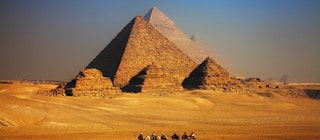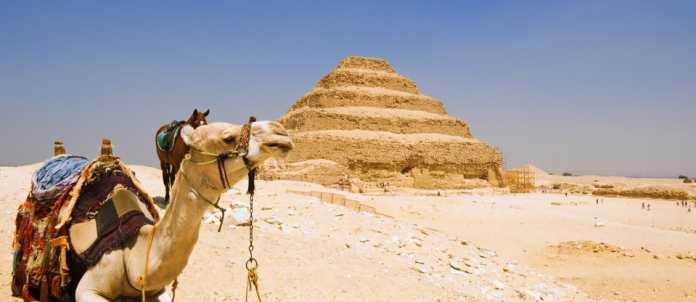Egypt welcomes you with its mighty Nile and magnificent monuments, the beguiling desert and lush delta, and with its long past and welcoming, story-loving people.
Pyramids & More
With sand-covered tombs, austere pyramids and towering Pharaonic temples, Egypt brings out the explorer in all of us. Visit the Valley of the Kings in Luxor, where Tutankhamun’s tomb was unearthed, and see the glittering finds in the Egyptian Museum in Cairo. Hop off a Nile boat to visit Dendara, Edfu or one of the other waterside temples, cross Lake Nasser to see Ramses II’s masterpiece at Abu Simbel, or trek into the desert to find the traces of Roman trading outposts. You never know – your donkey might stumble across yet another find, for that is the way many previous discoveries were made.
Two Religions
Egypt once ruled an empire from Al Qahira – Cairo, the City Victorious. The metropolis is packed with soaring minarets and medieval schools and mosques, some of the greatest architecture of medieval Islam. At the same time, Egypt’s native Christians, the Copts, have carried on their traditions that in many respects – such as the church’s liturgical language and the traditional calendar – link back to the time of the pharaohs. Tap into the history in Cairo’s early churches and in remote desert monasteries.
Beaches & Beyond
That empty beach with nothing but a candlelit cabin, and a teeming coral reef offshore: they’re waiting for you in Egypt. The coast along the Red Sea has a rugged desert beauty above the waterline and a psychedelic vibrancy below – rewarding to explore on a multiday outing to one of the globe’s great dives or on an afternoon’s snorkelling jaunt along a coral wall. There is even more space and just as much beauty in Egypt’s vast deserts. Whether you’re watching the sun rise between the beautiful shapes of the White Desert or the shimmering horizon from the comfort of a hot spring in Siwa Oasis, Egypt’s landscapes are endlessly fascinating.
Going With the Flow
The old saying that Egypt is the gift of the Nile still rings true: without the river there would be no fertile land, no food and a lot less electricity. Although people’s lives are increasingly physically detached from the water, the Nile still exerts a uniquely powerful role. Luckily for visitors, the river is also the perfect place from which to see many of the most spectacular ancient monuments, which is one reason why a Nile cruise remains such a popular way to travel.
Pyramids of Giza

The last remaining wonder of the ancient world; for nearly 4000 years, the extraordinary shape, impeccable geometry and sheer bulk of the Giza Pyramids have invited the obvious questions: ‘How were we built, and why?’. Centuries of research have given us parts of the answer. Built as massive tombs on the orders of the pharaohs, they were constructed by teams of workers tens-of-thousands strong. Today they stand as an awe-inspiring tribute to the might, organisation and achievements of ancient Egypt.
Ongoing excavations on the Giza Plateau, along with the discovery of a pyramid-builders’ settlement, complete with areas for large-scale food production and medical facilities, have provided more evidence that the workers were not the slaves of Hollywood tradition, but an organised workforce of Egyptian farmers. During the flood season, when the Nile covered their fields, the same farmers could have been redeployed by the highly structured bureaucracy to work on the pharaoh’s tomb. In this way, the Pyramids can almost be seen as an ancient job-creation scheme. And the flood waters made it easier to transport building stone to the site.
But despite the evidence, some still won’t accept that the ancient Egyptians were capable of such achievements. So-called pyramidologists point to the carving and placement of the stones, precise to the millimetre, and argue the numerological significance of the structures’ dimensions as evidence that the Pyramids were constructed by angels or aliens. It’s easy to laugh at these out-there ideas, but when you see the monuments up close, especially inside, you’ll better understand why so many people believe such awesome structures must have unearthly origins.
Most visitors will make a beeline straight to the four most famous sights; the Great Pyramid of Khufu, the Pyramid of Khafre, the Pyramid of Menkaure and the Sphinx. But for those who want to explore further, the desert plateau surrounding the pyramids is littered with tombs, temple ruins and smaller satellite pyramids.




